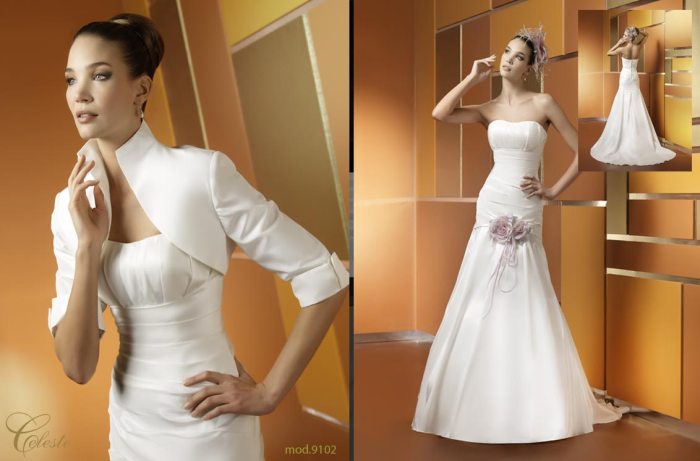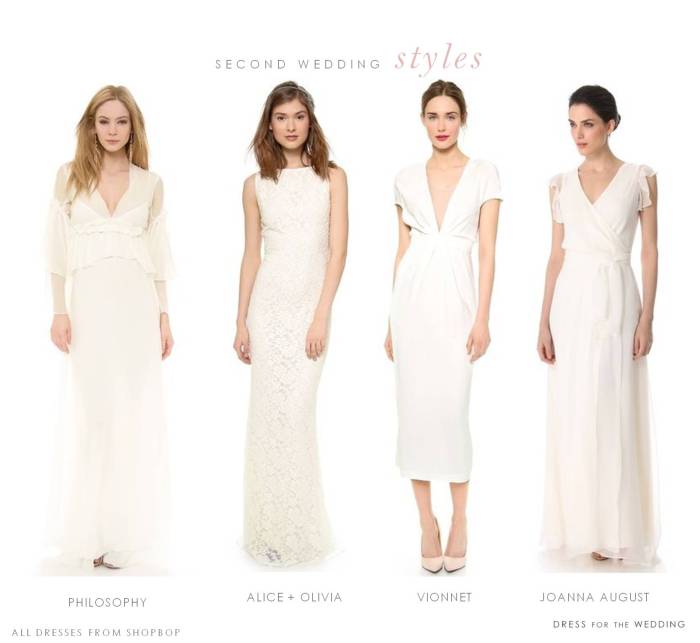Wedding Dresses for a Second Marriage
Styles & Trends for Second Wedding Dresses
Wedding dresses for a second marriage – Second weddings often reflect a different style and approach compared to first weddings. They tend to be more personal, reflecting the couple’s evolved tastes and life experiences. This section explores the key distinctions in style preferences, current trends, and the comparison between traditional and modern dress options.
Style Preferences: First vs. Second Marriages
First weddings frequently feature elaborate, traditional gowns, often emphasizing classic silhouettes and embellishments. Second weddings, however, often embrace a more relaxed and personalized aesthetic. Brides may opt for shorter hemlines, less formal fabrics, and unique details that showcase their individual style and personality. The emphasis shifts from adhering to tradition to expressing personal preferences.
Current Fashion Trends for Second Wedding Dresses
Current trends lean towards comfortable yet elegant designs. Tea-length dresses, A-line silhouettes, and separates (a skirt and top combination) are popular choices. Lace remains a classic choice, but modern interpretations often incorporate bolder patterns and textures. Simple, clean lines with subtle embellishments are also highly favored. For example, a sleek crepe gown with delicate beading or a flowing chiffon dress with a statement back detail exemplify this trend.
Traditional vs. Modern Dress Styles
Traditional wedding dresses often involve ball gowns, voluminous skirts, and intricate beading. Modern options offer a wider range of choices, including jumpsuits, separates, tea-length dresses, and minimalist designs. These modern alternatives prioritize comfort and personal expression without sacrificing elegance.
Choosing a wedding dress for a second marriage often involves a different approach than the first. Many brides opt for a more understated elegance, perhaps favoring a chic pantsuit or a sophisticated gown. If you’re attending a wedding as a guest, consider the style of the event; a beautiful option might be a square neck dress wedding guest which offers both comfort and style.
Returning to the bride, remember the dress should reflect her personal style and comfort, creating a memorable experience.
Second Wedding Dress Styles
| Style | Description | Appropriateness for Second Marriage | Example Fabrics |
|---|---|---|---|
| Tea-Length Dress | A dress that falls to the mid-calf or just below the knee. | Highly appropriate; offers a sophisticated yet less formal look. | Lace, silk, crepe |
| A-Line Gown | A classic silhouette that is flattering on most body types. | Appropriate; versatile and can be dressed up or down. | Chiffon, satin, tulle |
| Separates | A skirt and top combination, offering flexibility in styling. | Highly appropriate; allows for personalized choices. | Silk, crepe, lace |
| Simple Sheath Dress | A sleek, form-fitting dress with minimal embellishments. | Appropriate; elegant and understated. | Crepe, jersey, silk |
Budget & Cost Considerations
The budget for a second wedding dress varies greatly depending on individual circumstances and preferences. This section details typical budget ranges, cost-saving strategies, and cost comparisons between different purchasing options.
Typical Budget Range & Influencing Factors
The average budget for a second wedding dress can range from a few hundred dollars to several thousand, depending on factors such as the desired style, fabric, designer, and whether alterations are needed. A smaller, more intimate wedding will typically have a lower dress budget than a large, formal event. The bride’s personal financial situation and priorities also play a significant role.
Saving Money Without Compromising Style
Several strategies can help reduce costs without sacrificing style. Consider purchasing a pre-owned dress in excellent condition, choosing a less expensive fabric, or opting for a simpler design with fewer embellishments. Utilizing a skilled seamstress for alterations rather than a high-end bridal boutique can also save money. Shopping during off-season sales can also yield significant savings.
Cost Comparison: New, Pre-Owned, Custom-Made
Buying a new dress from a designer boutique will typically be the most expensive option. Pre-owned dresses offer significant cost savings, often providing high-quality gowns at a fraction of the original price. Custom-made dresses can range in price depending on the designer and the complexity of the design, potentially costing more than a new off-the-rack gown but allowing for complete personalization.
Wedding Dress Budget Breakdown
| Category | Estimated Cost |
|---|---|
| Dress Cost | $500 – $3000+ |
| Alterations | $100 – $500 |
| Accessories (veil, jewelry, shoes) | $100 – $500 |
| Undergarments | $50 – $150 |
Venue & Dress Appropriateness: Wedding Dresses For A Second Marriage
The wedding venue significantly influences dress selection. This section explores how different venues impact dress choices, providing examples of appropriate dress styles for various settings.
Venue Influence on Dress Selection
The formality of the venue directly impacts the appropriateness of the dress. A formal church wedding might call for a more traditional, elegant gown, while a beach wedding might be better suited to a flowing, less structured dress. The overall ambiance and style of the venue should be considered when choosing a dress.
Dress Examples for Different Venues

Source: vivifypicture.com
A garden wedding might lend itself to a romantic, flowing gown, perhaps in a light, pastel color. A rustic barn wedding might call for a more bohemian-inspired dress with lace or embroidery. A city hall wedding could accommodate a chic, modern jumpsuit or a simple, elegant sheath dress.
Factors to Consider When Choosing a Dress Based on Venue Formality
Consider the overall tone and style of the venue. Is it formal, casual, rustic, or modern? The level of formality will dictate the appropriateness of the dress’s style, fabric, and embellishments. The time of day and season can also influence dress selection. For example, a heavier fabric might be more suitable for a winter wedding than a summer wedding.
Venue and Suitable Dress Styles
- Beach Wedding: Flowing chiffon dress, short dress, simple A-line dress
- Garden Wedding: Romantic lace dress, floral-print dress, tea-length dress
- Church Wedding: Classic ballgown, elegant A-line gown, traditional lace dress
- Barn Wedding: Bohemian dress, rustic-inspired dress, jumpsuit
- City Hall Wedding: Simple sheath dress, jumpsuit, cocktail dress
Ethical & Sustainable Choices
Choosing a wedding dress with ethical and sustainable considerations is increasingly important. This section discusses ethical sourcing, sustainable materials, and the environmental impact of different dress options.
Ethical Considerations in Wedding Dress Selection
Ethical considerations include ensuring fair labor practices throughout the production process, supporting brands committed to transparency and responsible sourcing, and selecting materials that minimize environmental harm. Look for brands that prioritize fair wages, safe working conditions, and environmentally friendly production methods.
Brands Known for Ethical and Sustainable Production
Several brands are leading the way in ethical and sustainable wedding dress production. Researching and supporting these brands contributes to a more responsible and conscious consumerism. (Note: Specific brand names are omitted here to avoid endorsement and maintain objectivity. Independent research is encouraged.)
Environmental Impact of Different Dress Materials
Silk, while luxurious, has a significant environmental impact due to its production methods. Lace can be sustainably sourced but requires careful consideration of the materials and production process. Recycled fabrics offer a significantly lower environmental footprint. Choosing organic cotton or other sustainable materials reduces the overall environmental impact.
Environmental and Ethical Impact Comparison, Wedding dresses for a second marriage
| Dress Option | Environmental Impact | Ethical Impact |
|---|---|---|
| New Dress (conventional materials) | Potentially high, depending on materials and production methods. | Variable; depends on brand transparency and labor practices. |
| Pre-owned Dress | Low; extends the lifespan of an existing garment. | Positive; reduces demand for new production. |
| Rented Dress | Very low; significantly reduces resource consumption. | Positive; promotes a circular economy. |
Personal Style & Body Shape

Source: dressforthewedding.com
Choosing a dress that flatters your body shape and reflects your personal style is crucial. This section provides guidance on selecting a dress that complements your figure and personality.
Choosing a Flattering Dress for Different Body Shapes
Understanding your body shape helps in selecting silhouettes and necklines that enhance your features. A-line dresses are generally flattering on most body types. Empire waistlines are ideal for those who want to emphasize their upper body. Consider the overall balance and proportion when choosing a dress.
Dress Examples for Various Body Types
For example, a V-neckline can elongate the torso, while a sweetheart neckline can accentuate the bust. A-line dresses are versatile and suitable for various body shapes. Consider the overall silhouette and how it interacts with your body type.
Guiding Dress Selection with Personal Style and Preferences
Your personal style should be the ultimate guide. Consider your everyday style and adapt it to the wedding setting. Don’t be afraid to incorporate elements that reflect your personality and preferences. The dress should make you feel confident and beautiful.
Visual Guide: Necklines and Silhouettes for Different Body Types
This section provides a textual representation of a visual guide. Imagine a chart with different body shapes (e.g., pear, apple, hourglass) listed in a column. Across the top, list different necklines (V-neck, sweetheart, scoop) and silhouettes (A-line, mermaid, empire waist). Each cell would contain a description of how well that neckline and silhouette complement that body shape.
For example, a pear shape might be best suited to an A-line dress with a V-neck to balance proportions, while an hourglass shape could beautifully showcase its curves in a mermaid silhouette with a sweetheart neckline. An apple shape might benefit from an empire waistline to create a flattering visual balance.
Accessories & Details
Accessories play a vital role in complementing a second wedding dress and reflecting personal style. This section explores the importance of accessories and provides examples for different dress styles.
Importance of Accessories in Complementing a Second Wedding Dress
Accessories can elevate a simple dress or add a touch of personality to a more elaborate gown. They allow for personalization and can enhance the overall look and feel of the wedding attire. Choosing the right accessories can tie together the entire ensemble.
Appropriate Accessories for Different Dress Styles
A classic dress might pair well with delicate pearl jewelry and a simple veil. A bohemian dress might be complemented by layered necklaces, flower crowns, and ankle boots. A modern dress might look stunning with statement earrings and a sleek clutch.
Accessories Reflecting Personal Style and Wedding Theme
Accessories can help to reflect the bride’s personality and the overall wedding theme. For example, a bride with a love for vintage fashion might choose antique jewelry, while a bride with a minimalist aesthetic might opt for simple, understated accessories.
Accessory Ideas Categorized by Style
- Classic: Pearl necklace, simple veil, elegant earrings, classic pumps
- Bohemian: Flower crown, layered necklaces, ankle boots, embroidered belt
- Modern: Statement earrings, sleek clutch, minimalist jewelry, modern heels
- Rustic: Wooden jewelry, lace shawl, cowboy boots, simple hair accessories
Key Questions Answered
Can I wear white to a second wedding?
Absolutely! The tradition of only wearing white for a first marriage is outdated. White remains a popular choice for second weddings, but other colors are equally appropriate.
What if I want a very casual wedding?
A casual wedding allows for a wider range of dress styles. Consider a jumpsuit, a tea-length dress, or a separates ensemble.
How long should I start shopping for my dress?
Ideally, begin shopping 6-12 months before your wedding to allow ample time for alterations and potential delays.
Where can I find affordable second-hand wedding dresses?
Online marketplaces like Stillwhite and The Knot, consignment shops, and local bridal boutiques often offer pre-owned dresses at discounted prices.



















